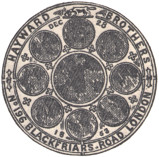
Up: Hayward

YOR: 36 of 113
|
|

| |
working out designs of their own. One of the first of these was The
Registered Cottagers' (and Emigrants') Stove, which was advertised
as suitable for "Private Families, Gentlemen in Chambers, Shooting Boxes,
Fishing and Pic-nic Parties, &c."
For their first two or three years in the Borough,
the Hayward brothers seem to have been content to develop and exploit

Coal plate of 1853 |
inventions from other hands. In 1852, however, Edward Hayward applied
for patent rights for "Self-Adjusting Micrometer Lock Spindles, Knobs
and Rises," which were granted. Here the influence of his uncle, James
Hayward, is apparent as it had been with chimney valves and smoke
consumers which that gentlemen had made and sold some thirty years
earlier.
As the nineteenth century moved forward, so the
residential character of that part of Southwark where the Haywards traded
became gradually merged and finally submerged in an atmosphere of
manufacturing. This meant that furnishing ironmongery in the immediate
neighborhood was a dying trade. The accent shifted to the needs of builders
and manufacturers.
Without realising it, Hayward Brothers were slowly
departing from the tradition represented by the ancient sign which hung
over their headquarters premises in Blackfriars Road and were entering a
new sphere embracing not merely Southwark, not only London, England, or
the United Kingdom, but the whole world.
As if to underline the fact, the decision was
reached to abandon the corner premises in Blackfriars Road and concentrate
upon developing and extending those previously used solely as a factory at
117/118, Union Street. This was a significant decision. It means that
Haywards no longer kept a shop or thought in terms of washers or tin-tacks
but had set out on the broad road leading to the more profitable wholesale
market. This was in
|
|